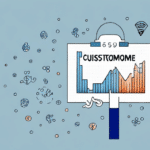The Importance of Customer Experience
In today's highly competitive market, providing an exceptional customer experience has become an essential aspect of running a successful business. Customers are no longer just looking for quality products or services; they also crave a memorable experience that leaves a lasting impression and keeps them coming back for more. According to Harvard Business Review, companies that prioritize customer experience see a significant increase in customer satisfaction and loyalty.
Why Customer Experience Matters
Providing an exceptional experience not only builds customer loyalty but also generates brand recognition and positive word-of-mouth marketing. According to a Bain & Company study, increasing customer retention rates by just 5% can increase profits by 25%–95%. Customers who have a positive experience are more likely to refer your business to friends and family and even leave positive reviews online. This, in turn, can attract new customers and increase your revenue.
Moreover, a great customer experience can differentiate your business from competitors. In today's market, where customers have numerous options to choose from, providing a memorable experience can make your business stand out. It can also help you retain customers and reduce churn rate. Additionally, a positive customer experience can lead to higher customer lifetime value, as satisfied customers are more likely to make repeat purchases and spend more money on your products or services.
Understanding Your Customers
Key Factors to Consider
One of the first steps to improving your customer experience is to understand your customers. This includes learning about their demographics, needs, wants, and preferences. By gathering and analyzing data on your customers, you can identify their pain points, prioritize their needs, and tailor your products or services to meet their expectations. Some key factors to consider when understanding your customers include:
- Age
- Gender
- Income level
- Geographic location
- Buying behavior
Another important factor to consider is their communication preferences. Some customers may prefer to communicate via email, while others may prefer phone calls or in-person meetings. By understanding their preferred communication channels, you can ensure that you are reaching out to them in the most effective way possible. Additionally, it's important to consider their level of tech-savviness and comfort with using digital tools, as this can impact their willingness to engage with your brand online.
Mapping the Customer Journey
Identifying Pain Points and Opportunities
Mapping out your customer journey can help you identify pain points and opportunities to enhance their experience. This involves tracking the customer's interactions with your business, from the initial contact to the post-purchase follow-up. By analyzing the journey, you can identify bottlenecks and areas where customers are having issues. According to a Gartner report, businesses that map their customer journey are 2.5 times more likely to have a superior customer experience.
Understanding the emotions and motivations behind each interaction is crucial. By putting yourself in the customer's shoes, you can gain a deeper understanding of their needs and expectations. This can help you tailor your messaging and service to better meet their needs, creating a more positive experience. Regularly reviewing and updating your customer journey map ensures you stay ahead of changing customer needs and preferences, continuously improving your service over time.
Building a Customer-Centric Culture
Employee Engagement and Training
Building a customer-centric culture within your business is essential to providing exceptional customer service. This requires a focus on the customer in every aspect of your organization, from your employees to your operations. Employee engagement and training are crucial components of this culture. According to Forbes, companies with strong customer-centric cultures outperform their competitors by 60%.
Engaging employees in the process by encouraging them to share ideas and feedback on improving customer service fosters a sense of ownership and pride in the company. This collaborative approach allows for a diverse range of perspectives and ideas to be considered. Additionally, ongoing training and development programs reinforce the importance of customer service and equip employees with the skills and knowledge needed to deliver exceptional customer experiences.
Leveraging Technology and Personalization
Enhancing the Customer Experience with Technology
Technology can play a significant role in improving your customer experience. This includes using tools such as chatbots, social media, and customer relationship management (CRM) software. Chatbots provide instant support, social media enables real-time engagement, and CRM software helps track customer interactions, monitor feedback, and organize customer data for personalized service.
According to a Salesforce report, 70% of customers expect companies to understand their needs and expectations. Leveraging technology to analyze customer data allows you to provide tailored product or service recommendations that meet their specific needs and preferences, increasing the likelihood of repeat business and customer loyalty.
Implementing user-friendly websites or mobile apps streamlines the customer journey, making it easier for customers to find what they need, make purchases, and access support. This reduces frustration and improves overall satisfaction with your brand.
Personalization Strategies
Personalization is key to providing a memorable customer experience. By customizing your products or services to meet individual customer needs, you offer a unique experience that sets you apart from competitors. This includes tailoring your communication to match customer preferences, such as using their name or addressing their specific concerns. According to PwC, 73% of consumers say that a good experience is key in influencing their brand loyalties.
Offering customization options allows customers to choose specific features or designs that meet their unique preferences. For example, a clothing company may offer custom sizing or color options for their products, making customers feel more connected and increasing the likelihood of a purchase.
Using data and analytics to understand customer behavior and preferences helps tailor your messaging to their specific needs and interests. For instance, if a customer frequently purchases a certain type of product, you can send personalized recommendations for similar products, enhancing engagement and loyalty.
Effective Communication and Feedback
Best Practices for Engaging with Customers
Effective communication is crucial for providing a positive customer experience. This involves being transparent, providing timely responses, and addressing any concerns promptly. According to Zendesk, 87% of customers think brands need to put more effort into providing a consistent customer experience.
Listening to your customers, understanding their needs, and providing solutions that meet their expectations builds trust and increases loyalty. Creating an open dialogue fosters strong relationships, making customers feel valued and appreciated.
Personalizing interactions by addressing customers by name, acknowledging their previous interactions, and tailoring responses to their specific needs enhances the customer experience. Using a friendly and conversational tone creates a more relaxed and approachable atmosphere, encouraging customers to engage more freely with your business.
Creating a Feedback Loop
To continuously improve your customer experience, it's essential to gather feedback and act on it. Creating a feedback loop involves actively seeking feedback from customers through surveys, reviews, or social media comments. According to a Qualtrics report, companies that implement customer feedback effectively can increase their customer satisfaction scores by up to 25%.
Analyzing the feedback and making necessary improvements demonstrates to customers that you value their opinions and are committed to providing the best possible experience. This proactive approach helps in identifying areas for enhancement and ensures that your services or products evolve to meet customer expectations.
Measuring Success and Handling Challenges
Key Metrics to Track
To ensure that you're providing an exceptional customer experience, tracking key metrics is essential. Important metrics include Net Promoter Score (NPS), customer satisfaction (CSAT), and customer retention rate. According to Qualtrics, organizations with high NPS scores grow at more than twice the rate of their competitors.
By analyzing these metrics, you can identify areas needing improvement and adjust your strategies accordingly. Continually monitoring and adjusting your approach ensures you meet the evolving needs of your customers. Additionally, tracking the average resolution time for customer issues can highlight areas where your team may need additional training or resources to handle inquiries more efficiently.
Monitoring team performance metrics, such as first response time, average handle time, and customer service agent satisfaction, helps identify areas where support or training is needed to enhance overall performance and customer service quality.
Navigating Difficult Situations
Even with the best intentions, difficult situations will inevitably arise. It's crucial to have a plan in place to handle complaints and challenges effectively. This involves being empathetic, actively listening to the customer, and providing a swift resolution. According to Forbes, 70% of angry customers will walk away from a company after an unsatisfactory response to their complaint.
Addressing issues promptly and taking responsibility can turn a negative experience into a positive one, strengthening customer loyalty. Implementing clear protocols for handling complaints ensures consistency and effectiveness in resolving customer concerns.
The Role of Social Media in Enhancing Customer Experience
Social media plays a vital role in enhancing the customer experience by providing a platform for engagement and real-time interaction. It allows you to address concerns, answer questions, and engage with your audience promptly. According to Business2Community, 67% of consumers have used social media for customer service.
Social media also enables you to showcase your brand's personality and values, building a personal connection with your customers. Having a clear social media strategy and actively engaging with your audience helps provide a positive and consistent customer experience.
Case Studies and Future Trends
Real-World Examples of Successful Strategies
Looking at real-world examples of successful customer experience strategies can provide valuable insights into what works. Case studies offer a glimpse into the strategies businesses have used to provide exceptional experiences and attract loyal customers. Companies like Amazon and Apple are renowned for their customer-centric approaches, leveraging technology and personalized services to enhance customer satisfaction. Understanding these strategies and applying them to your own business can help create a unique and memorable experience for your customers.
The Future of Customer Experience: Trends and Predictions
The customer experience landscape is constantly evolving, and it's important to stay ahead of the trends and predictions. Current trends include using data to personalize experiences, implementing artificial intelligence (AI), and creating omnichannel experiences. According to a Forrester report, businesses that adopt AI-driven customer service solutions are expected to see a 20% increase in customer satisfaction.
Understanding these trends and anticipating future developments allows you to provide a seamless and memorable experience for your customers. Adopting innovative technologies and strategies ensures your business remains competitive and continues to meet the evolving expectations of your clientele.
Conclusion
Improving your customer experience requires a holistic approach that involves understanding your customers, building a customer-centric culture, leveraging technology, and providing personalized and effective communication. By implementing these strategies and continually monitoring and adjusting your approach, you can provide an exceptional customer experience, build loyalty, and achieve long-term success.




















